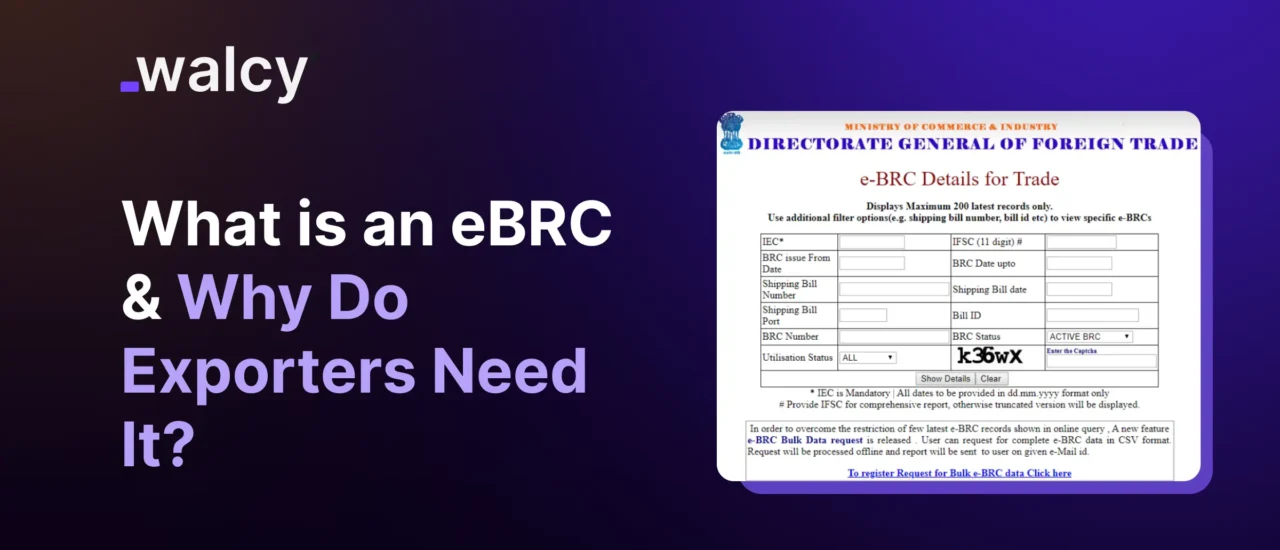In international trade, with fastness comes the primary need for efficient and streamlined processes for tracking payments and discharging relative regulatory obligations. One such tool is the Electronic Bank Realisation Certificate (eBRC) for exporters. This digital certificate, brought into effect by India’s DGFT and collaborative banks, has turned out to be one of the cornerstones in ensuring compliance and securing several export incentives.
Modern exporters are increasingly demanding automation, speed, and accuracy. Without a doubt, this is no longer the time when paper certificates and manual submissions could serve the intricate requirements of international trade in a befitting manner. Truly speaking, introducing the eBRC meets these challenges head-on. In this post, we will discuss what an eBRC is, why it is important for exporters, its broader impact on international trade, and the consequences for businesses.
What is an eBRC?
An eBRC is an electronic bank realization certificate that banks issue to confirm the receipt of export proceeds in foreign exchange. It simply means that the exporter’s bank has received payment for the goods or services exported from India.
Before the launch of eBRC, exporters needed to get a Bank Realisation Certificate from their bank in physical form. Due to manual processing, it was time-consuming and prone to errors apart from leading to extra administrative work. Now, against the backdrop of digital disruption, eBRC has come to replace paper-based BRC. It is a smooth and much more efficient way of accomplishing this task.
Evolution of the eBRC System
The journey from BRC to eBRC is fairly a great evolution of India’s export system. In the regime earlier, exporters used to file their BRCs physically with different government departments, including the DGFT, for claiming export incentives or even for regulatory compliance. The inefficiency of this manual process was sought to be rectified by the digital eBRC system. Bank systems are directly connected to government systems using an eBRC data center, which has now become a central repository of all issued eBRCs. This enables easy access to information by all the concerned parties in real-time.
The eBRC also facilitates easier reporting and reconciliation for authorities and helps reduce fraudulent claims by ensuring that the data provided is authentic. Such an automated system will, therefore, enable both the exporters and the government agencies concerned to instead concentrate on growth and development rather than on paperwork.
Why Exporters Need eBRC
The role of the eBRC in the operations of exporters cannot be overemphasized, with several benefits accruable from its adoption that make it much more than a simple tool for regulatory compliance. The major reasons exporters need eBRC are enumerated below:
Regulatory Compliance:
Exporters mandatorily have to establish that they have received payments against the supply of goods and services made abroad. The eBRC has to be furnished as proof and is, therefore, a compliance requirement in India. The certificate is to be furnished to agencies like DGFT and RBI. Provided that in case of failure to file an eBRC, there would be penalties and delays in processing export incentives and more.
Claiming Export Incentives:
The Indian government has the following incentive programs to promote exports: the Merchandise Exports from India Scheme and the Service Exports from India Scheme. Both schemes provide financial benefits based on the value of goods or services exported from the country. To claim the incentives under these schemes, an exporter is required to furnish his eBRC as proof of payment received from foreign buyers. The eBRC guarantees that only legitimate export transactions are rewarded with incentives, and without it, such benefits could be lost by the exporter.
Simplification of Documentation:
This eBRC saves much of the administrative workload and errors associated with manual paperwork. The digital format, in particular, allows for the speedy submission of documents to regulatory bodies, fastening the process of applying for incentives or fulfilling reporting requirements. More attention can now be paid by exporters to their core business activities rather than wading through complex paperwork and administrative tasks.
Centralized Data Management:
The eBRC data center has changed the way exporters and authorities deal with data. The eBRC data center acts as a one-stop center for all certificates ever issued under eBRC. It enables exporters to easily draw their certificates and regulators to track export proceeds in real time. This centralized system will enhance transparency and, hence, reduce discrepancies between data provided by banks and exporters. Efficient audits and compliance checks which will further help in bringing down frauds and financial malpractices are facilitated.
Facilitating Faster Exports:
Through the digitalization of documentation and the automation of procedures, the eBRC system quickens exports. The exporters no longer have to wait for physical documentation, since the generation of eBRCs happens automatically as soon as the payment is received. This basically enables exporters to fast-track transactions, claim incentives faster, and maintain a continuous flow of business.
Read about: Sending money to foreign bank account. Things to know.
What is a Bank Realisation Certificate? (BRC)
Before the digital shift, exporters had to obtain a Bank Realisation Certificate (BRC) from their banks as proof that they had received payment in foreign currency for their exported goods or services. The BRC was an important document for regulatory compliance and availing export benefits. Some of the challenges encountered with the paper-based BRC system were delays in the issuance of a certificate, the possibility of errors, and extra administrative costs. Such factors often gave rise to inefficiency, increased time in processing, and even misplacement of vital documents.
As technology evolved, so did the idea of an Electronic Bank Realisation Certificate (eBRC) as an electronic counterpart to the BRC, sorting out the various issues arising with paper-based processes. The eBRC integrates not only the documentation but also most of the government databases, which helps track and verify export transactions among the authorities. This made a huge difference regarding accuracy, reduced the administrative load, and hastened the processing of export-related documentation in a digital format.
Use of eBRC in Export Business
The introduction of the eBRC in the export business brought a lot of significant benefits that have changed the way exporters used to operate. Some of the major uses are as follows;
- Faster Submission and Approval
Now, the digitization of the Bank Realisation Certificate into eBRC has drastically reduced the time taken for submitting documents to the concerned authorities. Instead of handling physical copies of BRCs, exporters can now submit their eBRC online directly to the DGFT portal for quicker times of approval and processing for export incentives and refunds.
- Higher Security
State-of-the-art encryption and security protocols are embedded within the eBRC system to protect data and prevent fraud or unauthorized access of any nature. This enhanced security instills an additional element of trust among exporters, banks, and regulatory authorities in conducting export transactions over a safe medium.
- Transparency and Tracking
The data center at eBRC has made the process transparent, enabling each party involved in an export transaction to track and verify the status of payments. The system facilitates the exporters’ viewing of the status of their payment realization and enables the government to track export-related financial activities effectively. This real-time tracking facility is of particular help to large exporters dealing with a good number of transactions across various markets.
- Reduced Fraudulent Claims
In such a scenario, the possibility of fraudulent claims on export incentives is very low because the system is hooked onto banks and monitored by the government; thus, only valid export transactions come into consideration. This makes sure that only the real exporters of the country extract advantage from the government’s incentives.
- Efficient Tax Reconciliation
Tax reconciliation for an exporting business could be a risky and time-consuming activity. However, through the eBRC system, reconciliation is much smoother because it automates the linkage of export transactions with the tax filings. That means that taxpayers are empowered to make sure they are paying the right amount of tax and getting correct refunds, hence reducing possible disputes with tax authorities.
Challenges with the eBRC System
Though much can be said to be the advantages of the eBRC system, it, too, has its problems. One major concern about this system is data synchronization between banks and government systems. In case of differences or time lags in updating information, generation of the eBRC will get delayed, hence delaying export transaction processing. This might impact the timely claim to incentives or compliance requirements by the exporters. In some cases, there is not an ideal alignment of eBRC data with other regulatory or financial records, leading to confusion and an added administrative effort to remove discrepancies.
Furthermore, there is a case of difficult full adoption of the digital platform for small exporters. Either due to inadequate access to necessary technology or insufficient technical expertise, they are prevented from effectively accessing the eBRC system. This can cause inefficiency and shift back to manual operations, something that totally contradicts the main advantages of the eBRC system. In addressing the issues pointed out, there are continuous efforts at improving system infrastructure, providing extensive user training, and integrating banks and government databases. These improvements will let all exporters, regardless of size or technical capability, enjoy easier accessibility and efficiency in the eBRC system.
Conclusion
eBRC changed the way exporters did business by bringing in speed, security, and efficiency in the management of export proceeds and compliance with regulatory provisions. It substituted the time-consuming and paper-based Bank Realisation Certificates with their digital counterpart, making everything easier and quicker. In a way, the eBRC system reduces most of the administrative burden related to manual paperwork, freeing the exporter’s time to be engaged in core business activities and strategic growth. Such integration with government databases serves to bring more transparency, less fraud risk, and real-time traceability and verification of transactions.
This facilitates faster processing of export incentives and strengthens compliance with the applicable regulatory standards. As trade over the borders continues to grow, so does the role of the eBRC in support of every exporter who needs to be empowered to navigate the global marketplace with efficiency, thus driving business success and a more secure, yet open, export environment.
You shall like: Know everything about overseas payments
FAQs
What is an eBRC?
The eBRC stands for Electronic Bank Realisation Certificate, which makes sure that the payment for exports has been realized in foreign currency.
Why does an Exporter need an eBRC?
The eBRC is required by exporters for compliance and regulatory requirements, claiming government incentives offered, and automating their export documentation processes.
What is the difference between a BRC and an eBRC?
While a BRC is a paper-based certificate, an eBRC is an electronic version that assures faster, more secure processing with integration into government systems.
What is the eBRC data center?
A single system containing all issued eBRCs by banks for easy access by exporters/regulatory authorities.
How does eBRC help exporters?
The eBRC simplifies documentation, speeds up the process of claiming export incentives, and improves security; it will also aid in tax reconciliation.
Do follow us on Facebook and LinkedIn, to stay connected with us.



